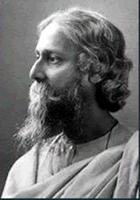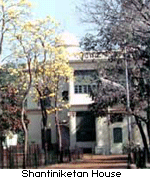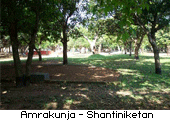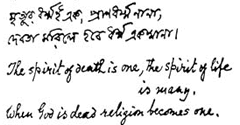 |
 Early life Early life
Rabindranath, the youngest son of Maharshi Debendranath Tagore was born in Jorasanko on 25th Baisakh, 7th May 1861. Rabindranath’s grandfather Prince Dwarkanath Tagore was a staunch supporter of Rammohun Roy in his attempts at reforming Hindu society. Dwarkanath’s son, Debendranath Tagore, also became pillar of the Brahmo Samaj Movement. In 1863 Debebendranath established a meditation centre and guest house on some land about 100 miles from Calcutta at a place called ‘Shantiniketan’, the Abode of Peace. Rabindranath’s grandfather Prince Dwarkanath Tagore was a staunch supporter of Rammohun Roy in his attempts at reforming Hindu society. Dwarkanath’s son, Debendranath Tagore, also became pillar of the Brahmo Samaj Movement. In 1863 Debebendranath established a meditation centre and guest house on some land about 100 miles from Calcutta at a place called ‘Shantiniketan’, the Abode of Peace.
Tagore’s family contributed large sums of money for the introduction of Western education, including colleges for the study of science and medicine. This peculiar situation explains the combination of tradition and experiment that came to characterize Rabindranath Tagore’s attitude to life. Rabindranath’s father was one of the leading figures of the newly awakened phase of Bengali society. He had been educated at one stage in Rammohun Roy’s Anglo-Hindu school and had been greatly influenced by Roy’s character, ideals and religious devotion. Debendranath Tagore was well versed in European philosophy and, though deeply religious, did not accept all aspects of Hinduism. He was to have a profound influence on his son’s mental and practical attitudes.
Rabindranath was the fourteenth child of his parents. His brothers and sisters were poets, musicians, playwrights and novelists and the Tagore home was thus filled with musical, literary and dramatic pursuits. The family was also involved with diverse activities at the national level.  He was also sent to a number of English-speaking schools, but he did not like their teaching style. He gradually withdrew from formal schooling when he was around 14 years old. The remainder of his education was carried out at home through his own personal efforts and with the help of tutors in various subjects. When Rabindranath was 12,his father took him to Shantiniketan, the meditation centre established in 1863. During their brief stay there, Debendranath gave his son lessons in Sanskrit, astronomy and the scriptures that formed the basis of his reformed religion. After these lessons
were over, Rabindranath was free to roam among the fields and forests. This routine continued when father and son journeyed on and stayed at Dalhousie in the Himalayan foothills. After lessons in Sanskrit, English literature and religion, the would-be poet explored the mountains and forests. Life in close proximity to nature was unknown to him in the urban surroundings of Calcutta. The close and affectionate contact between teacher and pupil that he felt when his father taught him was also completely absent in Calcutta. It was this childhood experience of the willing pupil enthusiastically following lessons given by his father in the manner of a noble teacher among agreeable surroundings that guided Rabindranath in establishing a school at Shantiniketan in 1901. He was also sent to a number of English-speaking schools, but he did not like their teaching style. He gradually withdrew from formal schooling when he was around 14 years old. The remainder of his education was carried out at home through his own personal efforts and with the help of tutors in various subjects. When Rabindranath was 12,his father took him to Shantiniketan, the meditation centre established in 1863. During their brief stay there, Debendranath gave his son lessons in Sanskrit, astronomy and the scriptures that formed the basis of his reformed religion. After these lessons
were over, Rabindranath was free to roam among the fields and forests. This routine continued when father and son journeyed on and stayed at Dalhousie in the Himalayan foothills. After lessons in Sanskrit, English literature and religion, the would-be poet explored the mountains and forests. Life in close proximity to nature was unknown to him in the urban surroundings of Calcutta. The close and affectionate contact between teacher and pupil that he felt when his father taught him was also completely absent in Calcutta. It was this childhood experience of the willing pupil enthusiastically following lessons given by his father in the manner of a noble teacher among agreeable surroundings that guided Rabindranath in establishing a school at Shantiniketan in 1901.
Work in the Brahmo Samaj
Rabindranath wrote Sandhya Sangeet - Evening songs, a volume of Bengali verse, came out in 1882. Between 1884 and 1890 various volumes of his poems appeared, together with a profuse output of prose articles, criticism, plays and novels. Tagore married when he was 23. At this stage, beyond his literary pursuits, he had begun sharing his father’s religious responsibilities. In 1911, Tagore took over the leadership of the Adi Brahmo Samaj. Under the influence of Rabindranath, Adi Brahmo Samaj was showing signs of revival. The old rule of allowing Brahmins to the pulpit were being  relaxed and men of other castes were being invited into it. The Tattwabodhini Patrika had secured a new band of writers and young men trained under Rabindranath came forward to take up the work of the Samaj. Rabindranath was also intimate with Trailokyanath Sanyal who inspired him in the composition of Brahmasangeet. Rabindranath stated a Boys Boarding school - the Brahamacharyashram (or Ashram) School was inaugurated on 22 December 1901 with only a few pupils, his son being one of them, and with an equal number of teachers. It was to be run on the
pattern of teachers and pupils relaxed and men of other castes were being invited into it. The Tattwabodhini Patrika had secured a new band of writers and young men trained under Rabindranath came forward to take up the work of the Samaj. Rabindranath was also intimate with Trailokyanath Sanyal who inspired him in the composition of Brahmasangeet. Rabindranath stated a Boys Boarding school - the Brahamacharyashram (or Ashram) School was inaugurated on 22 December 1901 with only a few pupils, his son being one of them, and with an equal number of teachers. It was to be run on the
pattern of teachers and pupils living together amidst natural surroundings and willingly accepting an
austere standard of living, often working with their own hands in Shantiniketan.The boys were trained to habits of economy, moderation, self control and due reverence of their teachers and their spiritual interests were taken care by encouraging habits of daily devotion. In 1912 Tagore left for the United Kingdom. Some of his poems and writings had already been translated into English and had attracted the attention of the well-known English painter Sir William Rothenstein and the poet W B Yeats. He made such an impression on the British writers and intellectuals that he was at once accepted as a great poet and intellectual. He was awarded the Nobel Prize for Literature in November 1913. living together amidst natural surroundings and willingly accepting an
austere standard of living, often working with their own hands in Shantiniketan.The boys were trained to habits of economy, moderation, self control and due reverence of their teachers and their spiritual interests were taken care by encouraging habits of daily devotion. In 1912 Tagore left for the United Kingdom. Some of his poems and writings had already been translated into English and had attracted the attention of the well-known English painter Sir William Rothenstein and the poet W B Yeats. He made such an impression on the British writers and intellectuals that he was at once accepted as a great poet and intellectual. He was awarded the Nobel Prize for Literature in November 1913.
Religion of Man
Tagore writes, "...the universe to which we are related through our sense perception, reason or imagination, is necessarily Man's universe. Our physical self gains strength and success  through its correct relationship in knowledge and practice with its physical aspect. The mysteries of all its phenomena are generalized by man as laws which have their harmony with his rational mind. ... I have expressly said that I have concentrated my attention upon the subject of religion which is solely related to man, helping him to train his attitude and behaviour towards the infinite in its human aspect. At the same time it should be understood that the tendency of the Indian mind has ever been towards that transcendentalism which does not hold religion to be ultimate but rather to be a means to a further end. This end consists in the perfect liberation of the individual in the universal spirit across the furthest limits of humanity itself....In the Sanskrit Language the bird is described as "twice-born"--once in its limited shell and then finally in the freedom of the unbounded sky. Those of our community who believe in the liberation of man's limited self in the freedom of the spirit retain the same epithet for themselves. In all departments of life man shows this dualism--his existence within the range of obvious facts and his transcendence of it in a realm of deeper meaning." through its correct relationship in knowledge and practice with its physical aspect. The mysteries of all its phenomena are generalized by man as laws which have their harmony with his rational mind. ... I have expressly said that I have concentrated my attention upon the subject of religion which is solely related to man, helping him to train his attitude and behaviour towards the infinite in its human aspect. At the same time it should be understood that the tendency of the Indian mind has ever been towards that transcendentalism which does not hold religion to be ultimate but rather to be a means to a further end. This end consists in the perfect liberation of the individual in the universal spirit across the furthest limits of humanity itself....In the Sanskrit Language the bird is described as "twice-born"--once in its limited shell and then finally in the freedom of the unbounded sky. Those of our community who believe in the liberation of man's limited self in the freedom of the spirit retain the same epithet for themselves. In all departments of life man shows this dualism--his existence within the range of obvious facts and his transcendence of it in a realm of deeper meaning."
Hindu Brahmoism
Rabindranath's argument was Brahmoism and reformed Hinduism were similar. He pointed out that status quo Hinduism filled with defects and abuses must be altered in a way that it reflects the "inner Hinduism" that is true Hinduism. In 1910 he was invited to give the Keshub Chandra Sen anniversary address. This was the first time since 1866 that the hard feelings between the Adi Brahmo Samaj and the Brahmo Samaj of India were dissolved. It was not Keshub's spirituality but his universality that had won Rabindranath over. One the idea that Brahmoism was the true form of Hinduism, Rabindranath was following the general lines of Adi cultural nationalsim. In one essay in May 1911 on "The Service of Brahmo Samaj" Tagore refused to acknowledge the decline of the Brahmo Samaj, though he readily admitted that "a phase of its history has ended." Brahmos should be jubilant, he argued, now that the "Hindu samaj has been awakened." Can we say that the work of the Brahmo Samaj is finished? Hardly. Brahmos should now "help the Hindu samaj follow the right path of reform." If Brahmos remain in "isolation" or in the "self-confinement of sectarianism," warned Rabindranath, then they will not only "place obstacles in the path of reformation," but assure their own extinction. In the very same essay, Rabindranath moved across the lines of Adi Brahmo Samaj nationalism to the heritage of Keshub Chandra Sen's quest for a universal religion. As, Rabindranath rephrased the problem: the world-especially the West - urgently needed the universal humanism of the Brahmo faith; 'The problem of Europe," he wrote, "is egocentric nationalism, a disease to be cured only by a universal ideal of humanity." It was the 'key role Of the Brahmo Samaj to help in saving the world from the "madness of nationalism."
Tagore condemned all forms of factionalism, sectarianism, communalism, and Brahmo nationalism. In one letter of March 18, 1913, to Ajit Chakrabarti, from Urbana, Illinois, where Tagore was visiting his son Rathindranath, the contrast between Brahmo universalism and the varieties of human divisiveness was never sharper. The fact that the letter began with an agonizing prophecy based on a contradiction between high ideals and actual practice in the West indicates that Tagore was beginning to view the problem of doladoli not as unique to Brahmos or Bengalis, but as a human problem. "The West which is about to destroy the world," wrote Tagore, "has nevertheless produced great men who have courageously fought against the fashion of placing nationalism above religion." In the same letter, Tagore was extremely perturbed by Brahmo sectarianism. He singled out Rammohun Roy as one of the greatest men produced in modern India. "But the Brahmo Samaj," wrote Tagore, "is belittling Rammohun Roy by judging him as a Brahmo minus the Hindu society." To be sure, because Tagore argued so forcefully for the idea of Hindu Brahmoism against Brahmo sectarianism, one could easily read into the letter the familiar Adi Samaj attitude of cultural nationalism. But in the context of the other letters it seems fairly certain that he aimed to integrate a smaller unit into a larger unit of Hindu society, while at the same time advocating that Hindu society integrate itself into the larger unit of Asian civilizations.
Brahmasangeet & Rabindrasangeet
Rabindranath Tagore taught us to sing, as a natural form of self-expression, like the birds.  He imbibed music from the atmosphere at home. One recalls that in the Maghotsav celebrations of 1887 Tagore sang a song to his father Debendranath, "Nayan tomare pai na dekhite, royecho nayane nayane..". Maharshi listened with closed eyes and then said if the King of the land could understand the words of this song he would have rewarded the poet. He immediately opened his safe and handed a cheque of Rs. 500 to Rabindranath. His works number twenty-nine volumes and include some sixty collections of verse, novels and plays. He is famous for his 2500 songs called "Rabindrasangeet". The whole Western world paid homage at his feet soon after he had translated into English his Gitanjali ("Song Offerings"). The devotional songs which are offerings to God find their place in the Brahmasangeet as glorifying the One Eternal Immutable being. Brahmasangeet gained its popularity at the time of Debendranath who composed a number of them. These songs were sung at the festivals of the Brahmo Samaj. Tagore was present in these festivals from his childhood and naturally imbibed the spirit of these songs. Brahmasangeet also appealed to people because of its tune - there was Dhrupad, Khayayal, Tappa, Western tunes, Baul, Bhatiali, Kirtan etc. Rabindranath with his vast repertoire changed the style and flow of Brahmasangeet. These were transformed from the lamentations of the Bhakta to a treasure piece of literature. These songs have not only united the country but the world as a whole. He imbibed music from the atmosphere at home. One recalls that in the Maghotsav celebrations of 1887 Tagore sang a song to his father Debendranath, "Nayan tomare pai na dekhite, royecho nayane nayane..". Maharshi listened with closed eyes and then said if the King of the land could understand the words of this song he would have rewarded the poet. He immediately opened his safe and handed a cheque of Rs. 500 to Rabindranath. His works number twenty-nine volumes and include some sixty collections of verse, novels and plays. He is famous for his 2500 songs called "Rabindrasangeet". The whole Western world paid homage at his feet soon after he had translated into English his Gitanjali ("Song Offerings"). The devotional songs which are offerings to God find their place in the Brahmasangeet as glorifying the One Eternal Immutable being. Brahmasangeet gained its popularity at the time of Debendranath who composed a number of them. These songs were sung at the festivals of the Brahmo Samaj. Tagore was present in these festivals from his childhood and naturally imbibed the spirit of these songs. Brahmasangeet also appealed to people because of its tune - there was Dhrupad, Khayayal, Tappa, Western tunes, Baul, Bhatiali, Kirtan etc. Rabindranath with his vast repertoire changed the style and flow of Brahmasangeet. These were transformed from the lamentations of the Bhakta to a treasure piece of literature. These songs have not only united the country but the world as a whole.
See Arnold A. Blake's article on the songs of Rabindranath Tagore |
| |
|